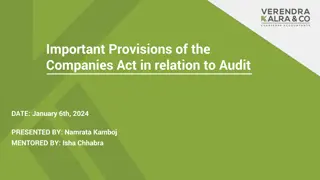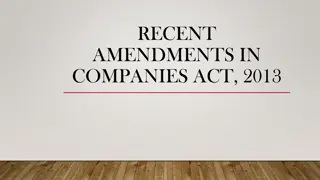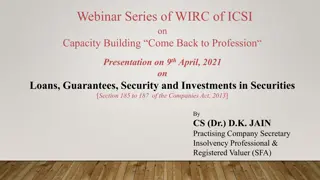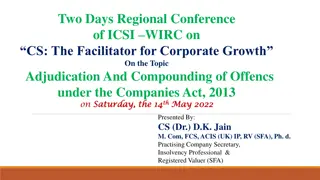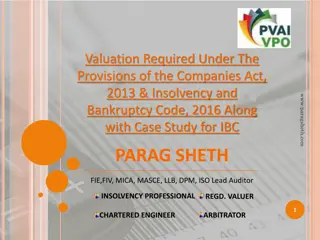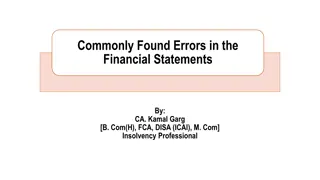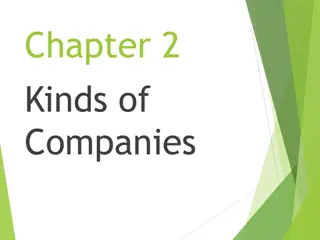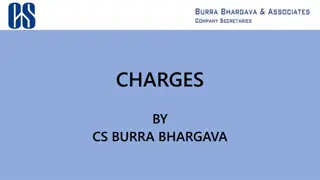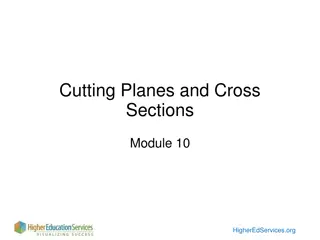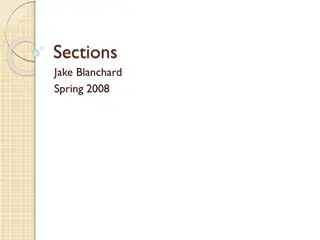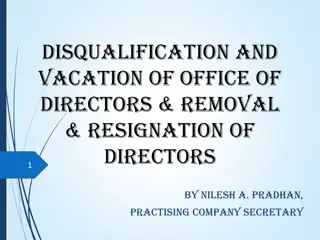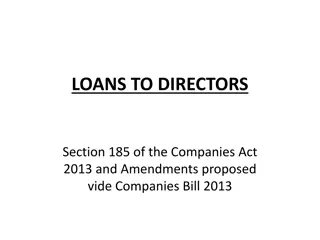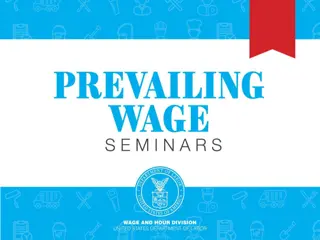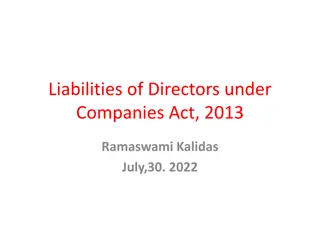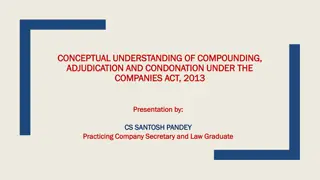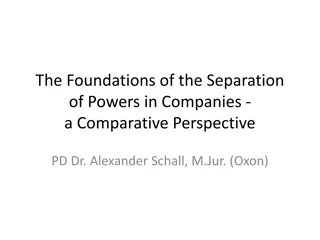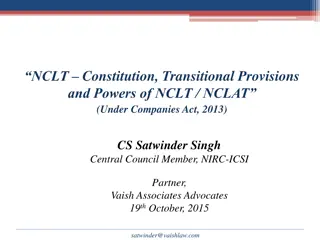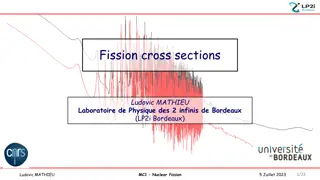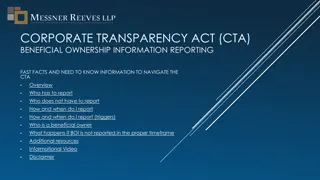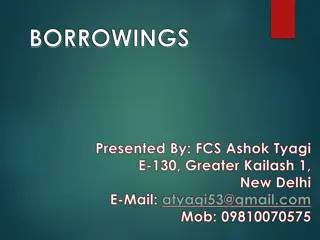Understanding the Impact of Sections 143(9) and 143(10) of Companies Act, 2013
Exploring the significance of Sections 143(9) and 143(10) of the Companies Act, 2013, and their implications on active regulators, worried investors, and normal auditors. The session delves into defending past audits, highlights auditing standards in India, and provides insights into regulators' observations. It reflects on NFRA and recent statistics concerning audit firms' debarments, emphasizing the importance of compliance with auditing standards to avoid repercussions.
Download Presentation

Please find below an Image/Link to download the presentation.
The content on the website is provided AS IS for your information and personal use only. It may not be sold, licensed, or shared on other websites without obtaining consent from the author. Download presentation by click this link. If you encounter any issues during the download, it is possible that the publisher has removed the file from their server.
E N D
Presentation Transcript
WHY? Section 143(9) and Section 143(10) of Companies Act, 2013
WHY? Active Regulators Worried Investors Normal Auditors
WHY THIS SESSION? Defending past audits done
AUDITING STANDARDS- INDIA Sl No 1 2 Area Quality Control General Principles and Responsibilities No of Standards 1 9 3 Risk Assessment and response to assessed risks 6 4 Audit Evidence 11 5 Using the work of others 3 6 Audit Conclusions and reporting 6 7 Specialised Areas 3 8 9 Standards on Review Engagements Other Assurance Engagements Total 2 5 46 5
AUDITING STANDARDS- IN PRACTICE - REGULATORS OBSERVATIONS
SUMMARY 2020-2023 54 orders against Audit firms Debarments
THE BIG ONES Almost 50% of Orders
DHFL Appointed was by Authorised Signatory Response- not appointed as Statutory Auditor Report given as Statutory Auditor did not comply with Paras 14, 15 and 16 of SA 200 "Overall Objectives of the Independent Auditor and the Conduct of an Audit in Accordance with Standards on Auditing"
DHFL Failure to comply with standards on auditing The EP was charged with non-compliance with SA 210 and displaying an absence of professional skepticism and professional judgment in documenting the objective and scope of the audit, thereby violating SA 200 as well. SA 210 stipulates that the auditor shall agree to the terms of the audit engagement with management or Those Charged With Governance (TCWG)
DHFL- SA 230 There is no evidence in the Audit File to indicate that the EP had performed audit procedures and as required by Para 8 of SA 230 documented the conclusion, nature, timing and extent of the procedures performed
NOT IN AUDIT FILE A.Understanding the branch operations, internal controls and responsibilities at various levels in the branch (refer to SA 315) b. Audit plan made after understanding the branch operations in accordance with SA 300 c. Determination of materiality levels (refer to SA 320) d. Understanding of the IT system controls (refer to SA 315) e. Trial balance for the previous year (refer to SA 510) f. Summary of the accounting policies, observations from previous audits, inspection reports, and internal audit reports (refer to SA 315)
NOT IN AUDIT FILE G. Proof of verification of trial balance items, including assets (substantive audit procedures) H. Procedures adopted to verify the loans sanctioned during the year (substantive audit procedures) I. KYC verification, anti-money laundering verification, security verification (substantive audit procedures).
DFHL The EP was charged with non-compliance with SA 700. As per SA 700 in order to form an opinion, the auditor shall conclude as to whether the auditor has obtained reasonable assurance whether the financial statements as a whole are free from material misstatement, whether due to fraud or error. Such a conclusion shall take into account, inter alia, whether sufficient appropriate audit evidence has been obtained and whether uncorrected misstatements are material, individually or in aggregate. Since, the unmodified opinion expressed by the EP is not supported by evidence, the EP was charged with non-compliance with SA 700
RESPONSE OF EP Most of the SAs referred in the show cause notice are not applicable for the said assignment
NON COMPLIANCE WITH AUDITING STANDARDS SA 300 6,7,8,9,10 failure to establish overall audit strategy and plan 315 5,6,11 no risk assessment for material misstatement 330 1,5,6 no response to risk assessment 320 10,11,14 determining materiality, performance materiality and documentation thereof 510 5,6,8 verification of opening balances 520 6 Design and performance of analytical procedures 530 4,6,7,8,9 Sample design, sample size and audit procedures 580 8,9,10 written representations from the management Paras Non-Compliance Would these Apply to Branch Audits?
NFRA ORDERS ARE SENT TO? MCA SEBI RBI ICAI Company IT Team, NFRA
APPEALS? Appellate Tribunal- yet to be set up?
IL & FS Partners had direct access to the top management?
IL & FS Independence Non-Audit Services
DEPENDENCE? Sl No Assignment 1 Advice on any issues identified by the client in terms of automation of data flow from ERP Systems Fee 15 2 Advisory services relating to growth strategy for IFIN Understanding of goals and aspirations 1.5 3 Ind AS conversion 44 4 Advising on applicability of witholding tax queries ITAT Assistance Analysing computation of income 55 5 TP Services 25 6 Integrity due diligence on the target companies and key principal 37 178
BARTRONICS Failure to maintain audit file and cooperate with NFRA Misuse of EOMs for issuing a modified audit opinion
EOM Emphasis of Matter paragraph A paragraph included in the auditor s report that refers to a matter appropriately presented or disclosed in the financial statements that, in the auditor s judgment, is of such importance that it is fundamental to users understanding of the financial statements.
CASE LAWS In the case of R.C. Dutta vs. Kailash C. Mishra , a Chartered Accountant was held guilty of professional misconduct under clause 7 of Part I of Second Schedule and other misconduct under Section 22 of the Chartered Accountants Act 1949 (the CAs Act, hereafter) for his failure to appear before Tax Authorities. CA Gora Chand Mukherjee was also held guilty of Professional Misconduct falling within the meaning of Clause 7 of Part I of the Second Schedule to the Chartered Accountants Act 1949 for delay in submission of information to RBI and for not submitting appropriate information
BARTRONICS Waiver of principal amount of Rs 9.74 crores P & L account or Reserves? AS 5
GOING CONCERN Net loss of Rs 12.67 crores for 31.3.2019 Accumulated loss of Rs 115.64 crores Net worth= - Rs 13.07 crores Negative working capital= - Rs 241.46 crores Total Debt= 83.19% of total assets Debt payment defaults of Rs 234.15 crores
THE CHARGE The SCN stated that in view of Para 6 and 12 of SA 570the Auditors were required to obtain a representation from the management of BCL and other evidence in support of the use of going concern basis and had to evaluate the same to conclude if any material uncertainty existed. However, the SCN noted that the audit file neither contained any representation from the management on the use of going concern basis, nor did it have any working by the Auditors regarding testing of appropriateness of such basis
THE CHARGE Non-planning of Audit The Auditors were charged with: (a) failure to perform the procedures as required by Para 6 of SA 210, which deals with ensuring the existence of pre-conditions for an audit; (b) non-compliance of the procedures relating to the acceptance of the audit of BCL as required by Para 12 of SA 220, which requires an auditor to obtain information before accepting an engagement with the new client, to ensure: Integrity of the principal owners, key managers of the entity. Competence of the engagement team to perform the audit engagement including time and resources. Compliance of ethical requirement by the firm and the engagement team
THE CHARGE non-compliance with Para 11 of SA 315, according to which the Auditors were required to understand the nature of the business of BCL by gaining understanding of relevant industry, applicable regulatory structure etc. at macro level and gaining an understanding of nature of the entity, its operations, its ownership, its governance & capital structure, and applicable financial reporting framework etc. at the entity level.
FACTS Unilateral write-back of liabilities Inventory values were about 50% of Current Assets. Valuation at estimated market price 44% of IPO proceeds were paid to one related party
AUDIT REPORT KAM- Inventory Valuation Use of KAM instead of Adverse Opinion 10 lakhs on firm, 5 lakhs on EP, 3 years debarment
HOW WOULD YOU DO THE AUDIT? OPC Total of 7 transactions including one purchase and sale transaction 100% Audit was done
PCAOB No Audit Plan No MRL
FRAUD DETECTION? SA 240 -The Auditor s Responsibilities Relating to Fraud in an Audit of Financial Statements elaborately deals with the auditor s responsibilities relating to fraud in an audit of financial statements. The SA requires the auditor to maintain professional skepticism throughout the audit and states: In accordance with SA 200, the auditor shall maintain professional skepticism throughout the audit, recognizing the possibility that a material misstatement due to fraud could exist, notwithstanding the auditor s past experience of the honesty and integrity of the entity s management and those charged with governance.
THE DIKTAT Statutory Auditors are under a mandatory obligation to report fraud or suspected fraud if they observe suspicious activities, transactions or operating circumstances in a company that indicate reasons to believe that an offence of fraud is being or has been committed against the company by its officers or employees. ADT-4 as per Section 143(12) Resignation does not absolve the auditor of his responsibility
THE FUTURE? NFRA is here to stay QRB and PRB will invariably follow the NFRA process. AQMM score will become a benchmark for assessment.
WHAT SHOULD AUDITORS DO? Defend the audit
HOW? Documentation, Documentation, Documentation Correspondence, Correspondence, Correspondence
STEP 1 Assess the degree of risk Control environment
STEP 2 Build a complete Audit file
COMPLETE AUDIT FILE Engagement Documentation Audit Planning Documentation Internal Control Evaluation Audit Evidence and Working Papers Specialist reports Adjustments and misstatements Audit Completion Communication and Reporting Archived Correspondence and Notes Post-Audit Documentation
COMPLETE AUDIT FILE Independence confirmation of the audit team. Quality control checks. Any consultation documentation (if there were issues the audit team needed additional help with)
AUDIT FILE- CRITICAL DOCUMENT Summary of audit findings Auditee response Conclusion and disposal


